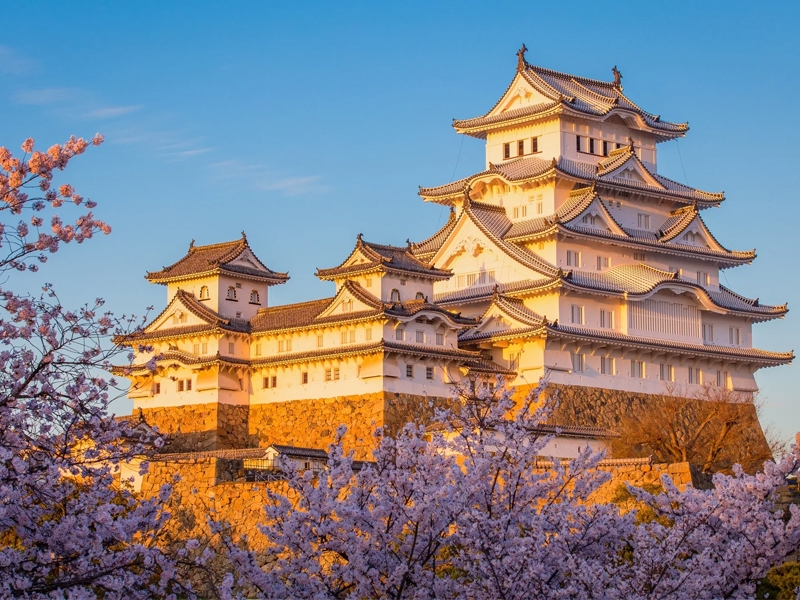
Japan is famous for cherry blossoms, tea ceremony, sophisticated geisha and harsh samurai. Samurai castles are the real architectural wonders of this unique country. There are about 50 castles in modern Japan, but most of these castles were rebuilt after fires, devastating earthquakes and the bombing of World War II. The same castles that were not destroyed were often significantly rebuilt by their owners. Only a few authentic castles have survived to this day.
HIMEJI CASTLE

Built in 1609, the “Castle of the White Heron” raised its white towers over the town of the same name. More than 80 stone and wooden buildings amaze with their elegance. The castle is surrounded by a labyrinth garden, in which many cherry trees grow. Many films were shot here, including one of the first James Bond films, and “The Last Samurai” with Tom Cruise. The castle is listed as a UNESCO World Heritage Site and is incredibly popular with tourists.A part of Himeji Castle is available for free inspection, but for those who want to go beyond the courtyard of the castle and the lawn with cherry blossoms, there is a ticket kiosk at the Hishi gate. Behind the gate there is the main tower, a small temple and the residence of the princess.
MATSUMOTO CASTLE

Raven Castle was built in 1594. The black citadel with a height of five storeys has become a symbol of the city of Nagano. This is the oldest wooden castle that has survived to the present day. The gloomy black “Raven” is surrounded by a moat with water in which Japanese carp swim.Local seasonal festivals such as the Drum Festival and the noodle festival are held here. During the day, you can take pictures with the characters of Japanese history – samurai or ninja. The garden and the area around the castle are open to the public for free, and for a small fee you can explore the castle from the inside. It has an exposition of the palace interiors in which the samurai and their families lived, and a small exhibition of medieval weapons.
AIZUWAKAMATSU CASTLE

Also known as Tsuruga Castle “Crane Castle” is a red and white ensemble built in 1384. The main seven-tiered tower was built in 1592. It was often rebuilt throughout its history, but in 2011 it returned to its original color, reminiscent of the plumage of Grus japonensis – the Japanese crane.A small exhibition working inside will tell visitors about the history of the castle, the way of life of its inhabitants. Holidays and festivals are held in the castle.The gardens surrounding the castle were laid out in the 14th century. In them you can enjoy cherry blossoms, wander along secret paths and wide alleys, enjoy a tea ceremony at the Rinkaku Teahouse tea house. The castle gardens are a favorite vacation spot for locals and tourists.
INUYAMA CASTLE

Inuyama literally means “dog mountain”. It has another name — Hakutei-“Castle of the White Emperor”. The main part of the castle was built in 1537, but during the restoration it turned out that the two lower floors are much older. They date back to 1440. Until 2004, the castle was privately owned by the Naruse family.The castle is located on a hill above the Kiso River and is considered one of the most traditional Japanese castles. It has been preserved almost in its original form despite all the changes in history. The castle is surrounded by cherry trees, blooming in spring, and maples – incredibly bright in autumn, surrounding it with a real riot of crimson and ochre.
Inuyama Castle hosts a festival of paper lanterns in spring, which are usually allowed to float freely on the Kiso River.
HIKONE CASTLE

Preserved in almost unchanged form since its construction in 1622, this castle is listed among the national historical monuments, it is a national treasure of Japan.The castle is located on Konkidzan Hill. His silhouette above the lake is especially striking on moonlit nights. The sound of the castle bell, striking every hour, carries far over the water. A spiral ascent leads to the castle, which is an element of the defensive fortifications of the castle. — enemies climbing it became an easy target for archers.The cherry trees surrounding the castle bloom a week later than in Tokyo and Kyoto. There is an exhibition of household and cultural items in the halls of the castle: ceramics, weapons, scrolls with calligraphy and screens.
NIJO CASTLE

The residence of the powerful shogun Tokugawa Ieyasu, built in 1603, is included in the UNESCO World Heritage List. A huge complex of buildings, including 2 rings of fortifications, two palaces — Hommaru and Ninomaru, and several gardens.
It is a real national treasure of Japan, a magnificent example of Edo architecture. There is a museum in the castle. One of its attractions are the halls with “nightingale floors” — specially fitted coating that warns the owner of danger.Around the castle there are magnificent gardens with a huge number of sakura trees blooming in spring, maples and gingko trees pleasing with bright foliage in autumn.
With Golden Holidays you can book accommodation in the best hotels in the world.
We guarantee expert advice.
Send A REQUEST
